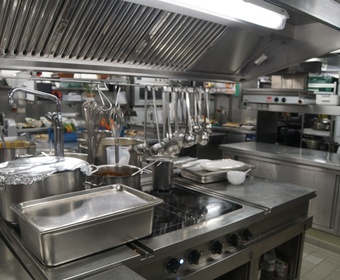
Hygiene and safety in the kitchen
Learning the right hygiene and safety skills might not be the most thrilling part of becoming a Chef de Commis, but these skills certainly rank among the most important. Think about it for a moment: A chef in a respectable kitchen must obviously take full responsibility for the health and wellbeing of all the staff and the guests.
Food hygiene
- The worst enemies of freshness are heat, light and air. So, it is easy to deduce that all produce and food should be stored under cold, dark and airtight (preferably in a vacuum) conditions.
- Pre-cooked food that you are keeping warm should maintain a temperature of at least 60°C to keep bacteria growth under control. At this temperature, the risk of dehydration is low.
- Always clean cutting boards andother equipment between use. Always store raw and cooked food separately.Always keep a tray under raw food to catch any drops. Use kitchen tools whenhandling food .
Kitchen hygiene
- Prepare a “mise en place” whenyou are cooking. It facilitates hygiene when things speed up and helps youto keep things apart that need to be kept apart.
- Have one set of kitchen tools for meat and fish, and another set of tools for vegetables. Even if you are alone in the kitchen, act like the pros and apply a “work station” attitude.
- Avoid unintentional freeze-drying by packing foodstuffs to be frozen in airtight packaging. Before placing in the freezer, wrap pieces of meat and fish tightly in plastic foil and then in a plastic bag. It will keep better and longer.
- Pour left over wine in smaller bottles, which you fill to the brim. This way the wine will keep for several weeks.
- If you lose the stopper to a bottle of carbonated liquid, it helps to store it in the fridge. The cold makes the gas less volatile and keeps the bubbles inside the liquid for a longer time.
- Water expands 10 per cent when frozen (yes, this is the reason why ice floats on top of water). Don’t forget to leave space for expansion.
- Extendthe freezing period forfish by first freezing it and then dipping it in cold water to create aprotecting layer of ice.
- Parboil vegetables that are to be frozen to preserve the flavors. Divide them into equal pieces and parboil them all the way through.
- The lower the temperature in your freezer, the better.
Get to know your pathogens
- Pathogens in food can be mold, fungus, virus, parasites and bacteria. The most common form of biological contamination is harmful bacteria, which cause 95 per cent of all food borne diseases. Microorganisms are found everywhere, but only about one per cent ofthem are hazardous to people – and different people are susceptible indifferent ways.
- Most pathogens thrive intemperatures between 5°C and 57°C. The meat you are cooking should not be keptwithin this interval for more than four hours. Most pathogens are killedat temperatures above 57°C.
- Cold does not kill pathogens,but they partly or fully cease to multiply in food that is stored in temperaturesbelow 5 ° (However, any poison they have produced will still be lurking in there.)
- Pathogens can travel when aninfected surface or raw material comes into contact with another surface. Thebest defense is good hygiene.
Some of the pathogens you are fighting:
- Salmonella is an infection by amicroorganism that attacks the digestive system.
- Thereare bacteria that causeboth poisoning and infection at the same time, such as E. Coli.
- Moldfunguses are more oftenresponsible for ruining food than for causing disease in humans.
- Virusesare not found naturallyin foodstuffs, but they can get there due to poor hygiene in the kitchen or where the produce was harvested.
- Parasiteshave other animals andplants as hosts. Amoebas and threadworms have a lifecycle that restarts in thenew host, that is to say in the stomach of your guest.
- Bacteria are the most common cause of food poisoning.Some need oxygen, some don’t, some can survive with or without it. Bacteria needprotein, water (moisture) and time. The higher degree of protein – as in meat –the higher the risk of infection .
- Mostpathogens die attemperatures above 57°C. The most dangerous temperature period, when pathogensthrive, is between 5°C and 57°C.
- Pathogens can be transferred when an infected surface or raw material is in contact with another surface. The best defense is good hygiene.
More kitchen organization
Want more tips on how to bring your kitchen up to par? Porch probably has the best guide on the internet:
Subscribe to our
Newsletter
Share page with others


